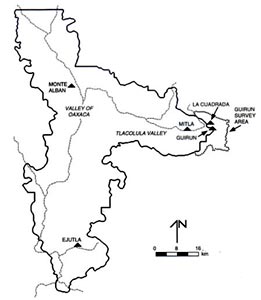
| FAMSI © 1999: Gary M. Feinman |
||
Systematic Settlement Survey Surrounding Guirún, Oaxaca, México
Research Year: 1995 Table of Contents
Introduction In January 1995, the Foundation for the Advancement of Mesoamerican Studies, Inc. (FAMSI) provided generous support to this investigator to conduct a regional survey in the area surrounding the Guirún site in Oaxaca, México (Figure 1). The survey of 110 km2 was completed in summer 1995, and a preliminary report was filed with FAMSI in September of that year. Shortly thereafter, an extension was granted so that the remaining project funds could be used for additional fieldwork at the Guirún site itself. In June and July 1996, the project prepared a detailed terrace-by-terrace map of the Guirún archaeological site. The site is situated in the terrain of San Lorenzo Albarradas and San Pablo Mitla (Tlacolula district) at the eastern edge of the Valley of Oaxaca (Figure 2). The project personnel included the Director Dr. Gary M. Feinman (University of Wisconsin-Madison) as well as Linda M. Nicholas (University of Wisconsin), Fausto Olivera Mendoza (Xaagá, Mitla), Everardo Olivera Díaz (Xaagá, Mitla), and Laura Waterbury (student volunteer, McGill University, Canada). The 1996 project represented the second year of a planned long-term effort to study the Classic-Postclassic period transition and specialized household production at the eastern edge of the Tlacolula arm of the Valley of Oaxaca. The summer 1996 field research was designed to produce a more accurate and detailed map of Guirún than is possible during regional survey, and to define the extent of the site during each phase of occupation. Another goal was to examine the nature of prehispanic stone working at the site. Through intensive survey, we also endeavored to study the intrasite distribution of different stone working activities. Prior regional surveys of the Tlacolula arm (1980, directed by Stephen A. Kowalewski [Kowalewski et al. 1989]) and the Guirún area (1995, directed by Gary M. Feinman [Feinman and Nicholas 1996]), as well as Nelly Robles García’s (1994) investigation of ancient quarrying activity at La Cuadrada, all had previously shown a significant association between the prehispanic inhabitants of Guirún and the exploitation and processing of stone materials. A final aim of the 1996 research was to evaluate the potential of the Guirún site for residential terrace excavations. Regional survey work (and subsequent visits to the site) indicated that a significant proportion of Guirún terraces were well preserved and might lend themselves to further subsurface investigation. When the 1996 field project began, 70 terraces had been mapped at the Guirún site as part of the 1980 and 1995 regional surveys. However, the regional survey mapping efforts were limited both by extremely heavy vegetal cover in certain parts of the site and by recent farming in others. Construction of modern agricultural terraces confounded the mapping of ancient terraces in parts of the site. In 1980, preceding the availability of topographic maps, air photographs were employed in mapping. Yet, the photos for this area were unclear due to the dense mountain vegetation. Furthermore, the placement of Guirún at the junction of the 1980-1995 survey regions provided an additional complication. In 1995, we recognized that a more detailed map of Guirún was necessary. The 1996 intensive survey was needed to integrate, systematize, and refine the observations made in 1980 and 1995. Click to download the report in PDF format: Systematic Settlement Survey Surrounding Guirún, Oaxaca, México (302 KB) The PDF files require Adobe Acrobat Reader.
Submitted 03/01/1997 by: |
||
| Return to top of page | ||
|
Text links to all pages at this site are available at the FAMSI INDEX |
||

